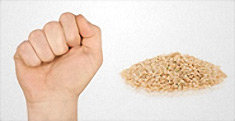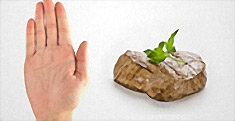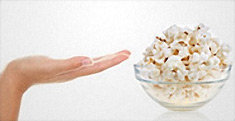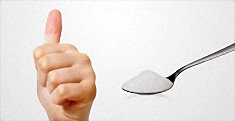Skip To Content
How to Start & Maintain a Healthy Diet
- 5 Simple Substitutions
- 2-day Meal Plan
- How to Read Nutrition Facts
- Healthy Snack Ideas
- Portion Size Guide
- 6 Superfoods to Add to Your Diet
Mediterranean Diet
Healthy Portion Sizes
Did you know that a portion and serving size are different? A portion is the amount of food you decide to eat. A serving is the measured amount. This is presented on a nutrition label, and explains the amount of calories each serving is equal to. By watching the portion and serving size, you can enjoy your favorite foods in the right amounts. The American Heart Association's Hand Method and the U.S Department of Health and Human Services Object Method are two helpful ways to watch your portions.
portion size: the hand method
To figure out your portions wherever you are, simply look at your hands for reference.
You can also try relating your portions to everyday objects.
The National Institute of Health and the U.S. Department of Health and Human Services have shed interesting light on how much our portions have changed in the last 20 years.¹ This is referred to as "Portion Distortion." Here are seven everyday foods that have grown in size:
Muffin
Cheeseburger
French Fries
Pizza
Popcorn
Chocolate Chip Cookie
 |
The size of an adult fist is roughly a 1 cup. This is helpful when looking at how much starch (like rice and pasta) we want on our plate. This is also recommended for our veggies and fiber. |
 |
The size of your palm measures roughly 3 ounce. Use this as reference for meat, fish or poultry. |
 |
A full handful is roughly 1 ounce. Use this to measure out nuts, trail mix, popcorn and chips. |
 |
Your thumb is roughly 1 ounce. Use this to measure peanut butter spreads or diced hard cheese. |
 |
The tip of your thumb is 1 teaspoon. Use this for cooking oils, mayonnaise, condiments, buttery spreads, sugar syrups and sugar. |
portion size: the object method
You can also try relating your portions to everyday objects.
- 1 cup is equal to a baseball. Use this for fruits, greens and veggies, yogurt and cereal.
- 1 ounce is equal to a golf ball. Use this for peanut butter and dips.
- 3 ounce is equal to a deck of playing cards. Use this for meat and poultry.
- 3 ounce is equal to a check book. Use this for seafood.
- 1 tablespoon is equal to a poker chip. Use this for buttery spreads and oils like mayonnaise.
- A DVD is the size of waffles or pancakes.
- A hockey puck is equal to the size of a bagel.
- One piece of chocolate is the size of a dental floss package.
portion sizes over time
The National Institute of Health and the U.S. Department of Health and Human Services have shed interesting light on how much our portions have changed in the last 20 years.¹ This is referred to as "Portion Distortion." Here are seven everyday foods that have grown in size:
Bagels
- 20 years ago a bagel was 3 inch in diameter and 140 calories.
- Today a bagel is 6 inch in diameter and 350 calories.
- That's a 210 calorie difference!
Muffin
- 20 years ago a muffin was 210 calories (1.5 ounces).
- Today's muffin is 500 calories (4 ounces).
- That's a 290 calorie difference!
Cheeseburger
- 20 years ago a cheeseburger averaged 333 calories.
- Today's cheeseburger averages 590 calories.
- That's a 257 calorie difference!
French Fries
- 20 years ago French fries averaged 210 calories (2.4 ounces).
- Today's French fries average 610 calories (6.9 ounces).
- That's a 400 calorie difference!
Pizza
- 20 years ago two slices of pizza averaged 500 calories.
- Today two slices of pizza equal 850 calories.
- That's a 350 calorie difference!
Popcorn
- 20 years ago the average amount of popcorn was 270 calories (5 cups).
- Today's popcorn is 630 calories (11 cups).
- That's a 360 calorie difference!
Chocolate Chip Cookie
- 20 years ago a chocolate chip cookie was 55 calories (1.5 inch in diameter).
- Today's chocolate chip cookie is 275 calories (3.5 inch in diameter).
- That's a 220 calorie difference!
¹National Institute of Health and U.S. Department of Health and Human Services. Portion Distortion